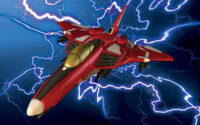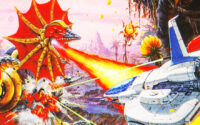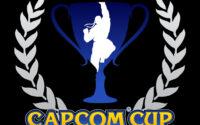50 Essential Commodore 64 Games [Part 2]
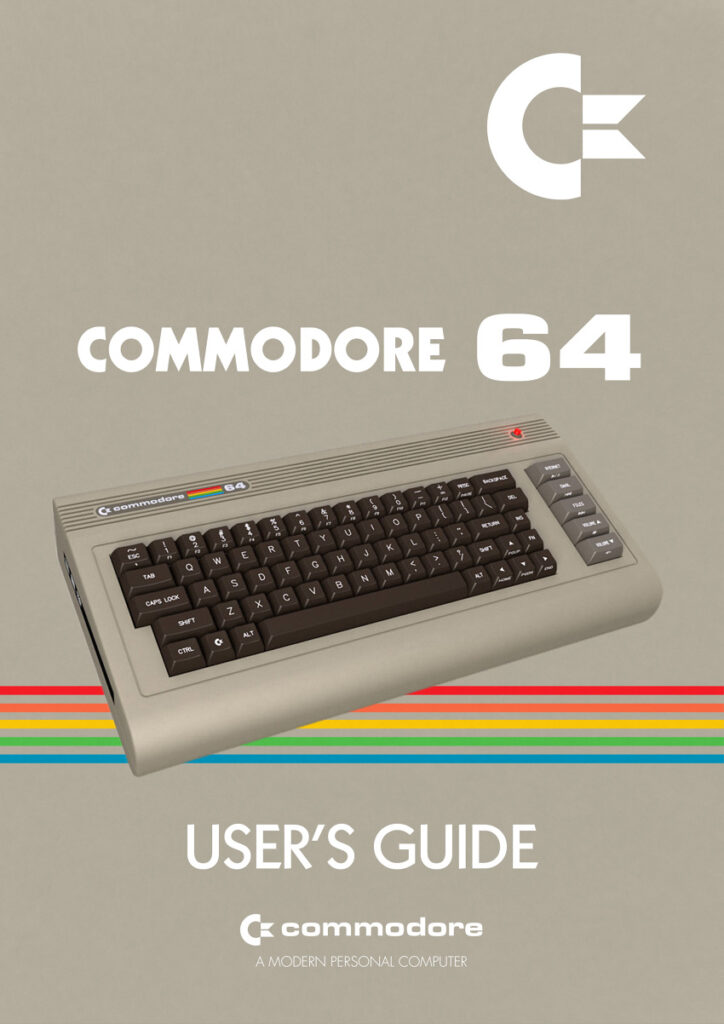
This article is a continuation of 50 Essential Commodore 64 Games [Part 1].
26. Last Ninja 2 (System 3, 1988)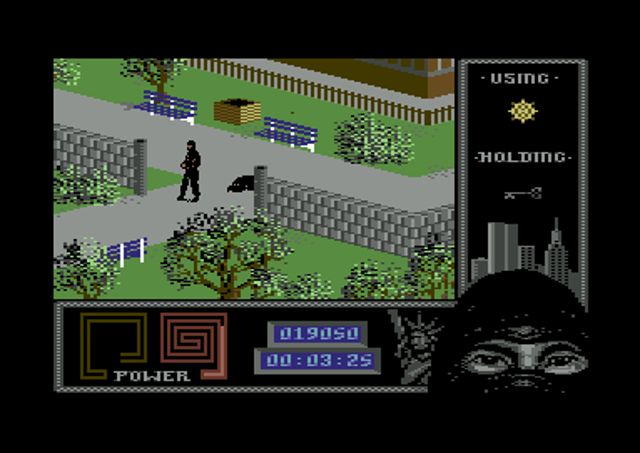
And then we got the sequel… Which was an even bigger hit. System 3 dared to set the game in modern time New York instead of ancient Japan, and it worked. Last Ninja 2 plays just like the original, and the journey through the six levels is just as surprising. It was Matt Gray’s turn this time to provide the 13 songs for the soundtrack, and they are just as iconic and great as in the original. In 1990, System 3 also released Last Ninja Remix, which was the same game but with a kick ass soundtrack by Reyn Ouwehand and an animated intro that showed how Armakuni ended up in 80’s U.S.A. And Last Ninja 3 was released in 1991. While it was technically a good game, it wasn’t as fun and it didn’t nearly sell as well as the predecessors. Last Ninja 2 is another must and probably the best sequel ever up to that point in time. And dare I say it? The C-64 version was the winner of them all.
27. Mega Apocalypse (Martech, 1987)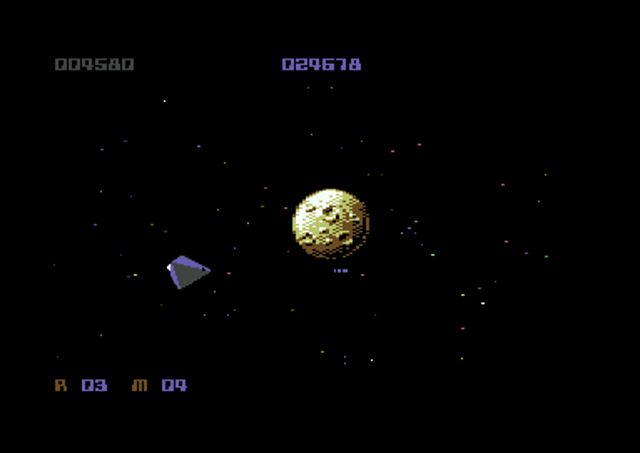
Crazy Comets was fun, but the sequel, Mega Apocalypse, is where it’s really at – A breathtaking and frantic Shoot ’em Up where you swirl around in deep space, blasting at planets and comets totally out of any gravitational control. The danger comes from the fact that the planets grow and get harder to destroy if you don’t destroy them as quickly as possible. (And you can imagine what happens when you collide with them.) The game has two player simultaneous co-op. But more than half of the game is Rob Hubbard’s wonderful seven and half-minute remix of the original Crazy Comets-tune. Mega Apocalypse has some of the best music you’ll ever hear on the C-64.
28. Morpheus (Rainbird, 1987)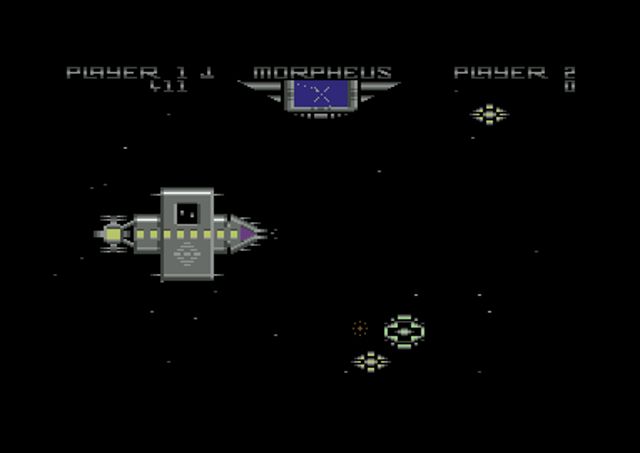
Definitely not just “another Shoot ’em Up set in space” – Everything about Andrew Braybrook’s Morpheus screams originality and innovation, and there is way more than meets the eye. First of all, your ship is customizable. (And it grows huge as it gets upgraded – It eventually takes up almost a third (!) of the screen.) And it has to be customized with a larger hull, defense systems, weapons and other gadgets if you want to survive on each of the fifty levels. The objective is to shut down a Nucleus on every level by destroying Orbitals. Which is easy – In the beginning! The ship stays static on the left side of the screen but you fly in eight directions and navigate using a radar. And there is a whole bunch of surprises on the way – The game even uses its own timescale, and the levels are divided into positive and negative phases which affect the universe in different ways. It’s pretty tricky to figure out Morpheus without instructions, but once you get into it, you’ll be positively surprised.
29. Mutants (Ocean Software, 1987)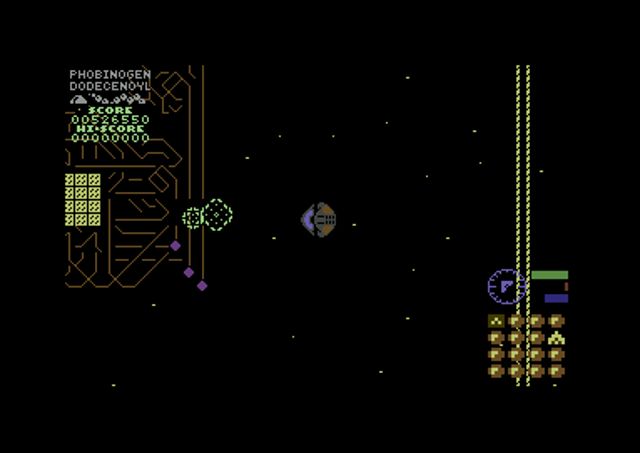
Them vidya games are getting too easy for ya?! Dig into this deep space biological warfare, then. Mutants was notorious for its difficulty, but loved the same for its very original design. (Denton Designs, again.) It’s hard as hell at times, sure, but it is possible to get the hang of it. You combat different types of mutated viruses in fifteen confined areas using three different weapons / defenses. Once you have collected a gadget (that’s eventually used to obliterate the virus), you either deliver it to a maze-like space station or move on to the next area. When you have all the parts, the mutants are destroyed and the game… Gets even harder…! Imaginative graphics throughout and two excellent tunes by Fred Gray help to improve the quality.
30. Myth: History In The Making (System 3, 1989)
Another extremely good-looking and polished-to-the-max System 3-title. And atypically for this particular developer, they made a platformer. Myth deals with exactly that – Mythological shenanigans in various mythological places. You fight your way through Hades, Ancient Greece, Egypt, a Viking ship and even space on some astral or metaphysical level. On your hazardous travels, you encounter a Hydra, Thor, Medusa, Tutankhamen and other antagonists. The variety and the amount of details is simply astonishing. The game only has (good) sound FX except for the fantastic title music from the always reliable Jeroen Tel from Maniacs Of Noise. Conan: The Mysteries Of Time on the NES is basically the same game, but it’s extremely watered down and shockingly poorly adapted.
31. Parallax (Ocean Software, 1986)
Sit through that unforgettable epilepsy warning-intro with the hypnotic 11-minute Martin Galway-composition before starting the game. At least once. I don’t know what kind of mood it sets, but it carves it in stone. And the tune initially showed what exactly the SID-chip could do. Anyway, the game itself mixes a multi-directional parallax-scrolling sort of three-dimensional Shoot ’em Up with a good deal of adventuring as you look for the passwords (received from scientists) used to crack a powerful computer that has the game’s five levels on lock down. You either fly around in your ship and blast aliens or walk around the surface of the planets… It’s… Challenging. To say the least. Sensible Software did some groundbreaking stuff in their early says.
32. Project Firestart (Electronic Arts, 1989)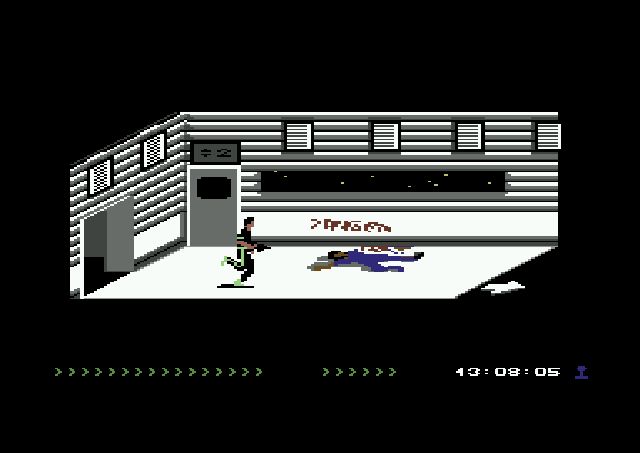
An unfairly “forgotten” C64-exclusive that mixes cinematics and a very Alien-like plot with survival horror and exploration. And this was years before it became any kind of standard – Even in the 16-bit era. The game takes place on a spaceship called The Prometheus (!) outside Titan. Something possibly very unpleasant has obviously happened on board, so it’s up to you to investigate and report back. And there are surprises around nearly every corner – Most of them of the nasty kind. The eerie silence and the minimalistic sound-scape helps to enhance the mood and the game has no problem keeping the player invested in what’s happening. What about good and bad endings? There are those as well. Developer Dynamix started at the top.
33. Raid On Bungeling Bay (Brøderbund, 1984)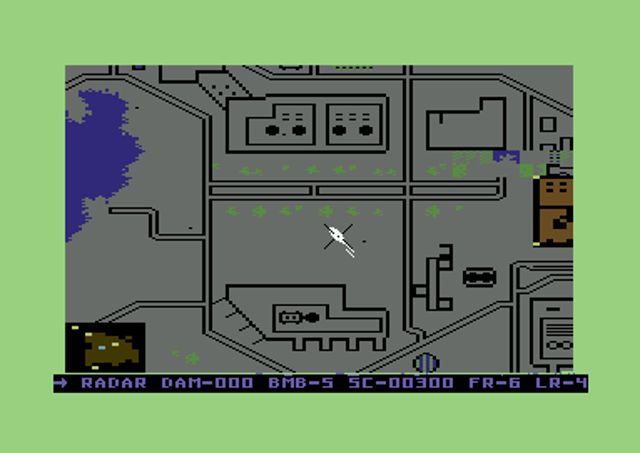
Before Sim City, there was Raid On Bungeling Bay. It actually was Will Wright’s very first game, but it can be mentioned (as it has everywhere else) that there are mechanics in this game that would turn up in the first Sim City – Not so much the helicopter-aided bombing on enemy territory, which is up to the player. You have to level a bunch of factories with the ground and subsequently prevent the construction of artilleries before the bad guys grows strong enough to take over the world. (Starting with Bungeling Bay, of course.) You also have to defend your home base and figure out which targets are most crucial to take out. The game was pretty sophisticated for its time and the controls are just perfect.
34. Rubicon (21st Century Entertainment, 1991)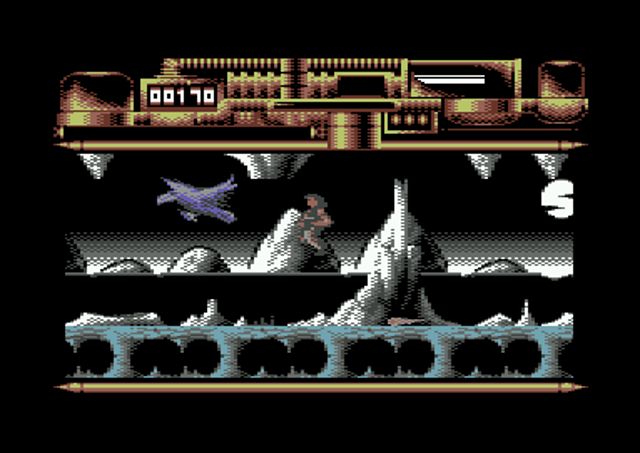
Others have said it (probably many times), but this could be the spiritual successor to Hawkeye – The gameplay is similar and there are huge monsters that you barely ever saw on the good old C-64. The C-64 was reaching the very end of its commercial lifespan at this point, so Rubicon was probably and unfairly overlooked because of this reason. (And most Commodore-fan(boy)s had moved on to the Amiga.) The game was developed by Twisted Minds (two Swedish guys) with Maniacs Of Noise providing, once again, one of their finest soundtracks ever. Rubicon may be a bit short with its five levels, but it totally excels in every regard otherwise – Right down to the presentation. It just has to be said – Again – The Amiga version felt bland and soulless compared to this gem.
35. Sacred Armour Of Antiriad, The (Palace Software, 1986)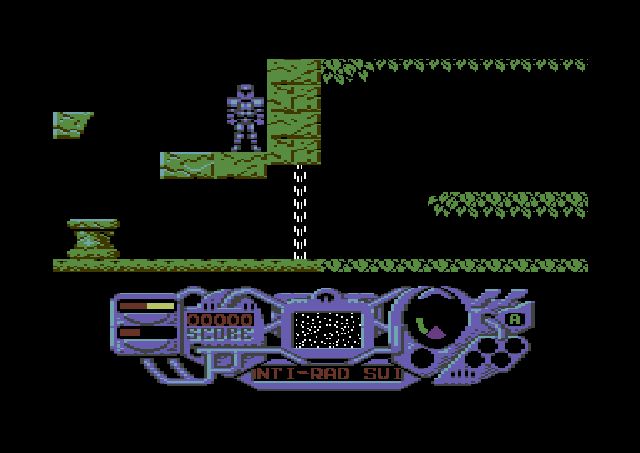
There sure has been lots of platforming games on this list, but it’s not really my fault – The C-64 handled most of the just right, especially the ones with static screens. The mission is, like it usually is, to annihilate enemy forces from your normally peaceful environment. You control this prehistoric dude called Tal and look for the armor of Antiriad that will help you on your quest. This hi-tech armor will let you fly and also withstand the high levels of lethal radiation as you reach the higher levels. But the armor needs power to function of course. The game has some truly impressive and colorful graphics, and a very big map to explore. In many cases this was more than enough and Antiriad is no exception.
36. Shadowfire (Beyond Software, 1985)
There is just something special about Denton Designs’ Shadowfire and its direct sequel Enigma Force. I know the former was one of the first (If not the first.) icon-operated adventure game with six controllable protagonists, but at the same time, it’s worth the time just to figure out how to actually control the game – Just because it has so many new functions and features. And Enigma Force improves some of them. Shadowfire is a rescue mission for which you’re given 100 real minutes to complete, and Enigma Force has you hunting down the baddie from Shadowfire. Four of the characters (Maul, Sevrina, Sylk and Zark) return in the sequel. It quickly became a personal guilty pleasure. Fred Gray composed some characteristic tunes for both games and both games have a distinct and charming look. Simplicity is king.
37. Skate Or Die! (Electronic Arts, 1988)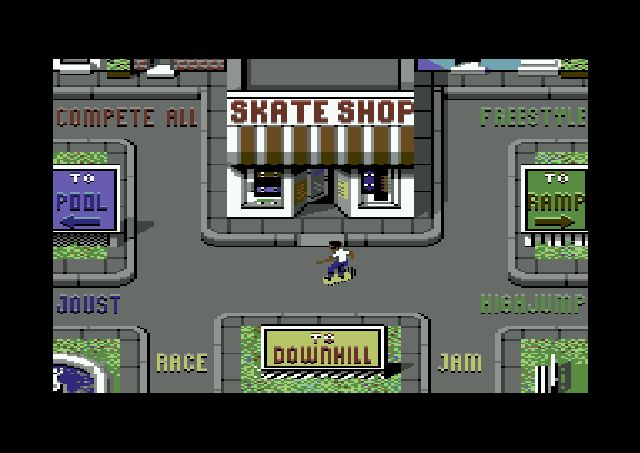
After Rob Hubbard’s last (commercial) piece of music for the C-64, you start in Rodney Recloose’s skateboard shop with two options – “Go practice” or “Go compete”. In the streets, you choose what event you want to compete in. (Or all of them.) There are five to choose from – Two half-pipe events, two downhill ones and the pool joust. Good fun. After the severe disappointment that was the port of 720º, it was nice to see that a similar game could be done well. The skateboarding dudes are extremely well animated. The only thing that just isn’t good is the in-game music. (Which wasn’t done by Hubbard.) It’s just bloody horrible. Put on some “Suicidal Tendencies” in the background instead.
38. Spherical (Rainbow Arts, 1989)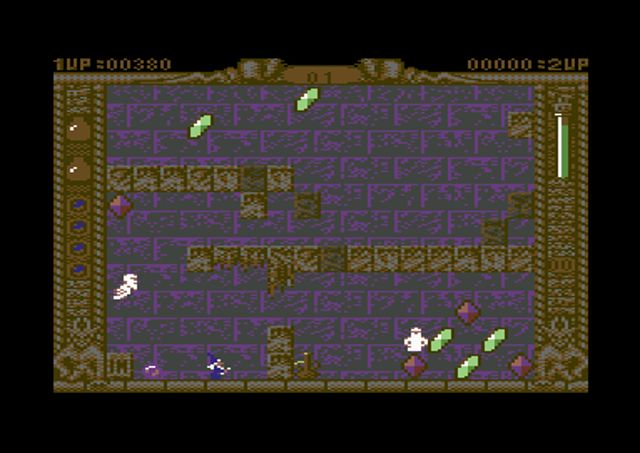
Mind-bending, captivating and very fun puzzle / platformer where a wizard has to guide a rolling sphere to the exit on each level. The wizard can conjure blocks of stone which are used to form extra platforms, and the blocks can also be removed just as easily. Very often, this is necessary since you have to prevent the sphere from rolling in the wrong directions. Two players can co-operate as a team and the game also has enemies that will make everything harder. But there are bonuses to collect on each level too. Chris Hülsbeck’s and Ramiro Vaca’s soundtrack is a definite highlight and there are seven extremely good title-tunes to choose from.
39. Target Renegade (Imagine Software, 1988)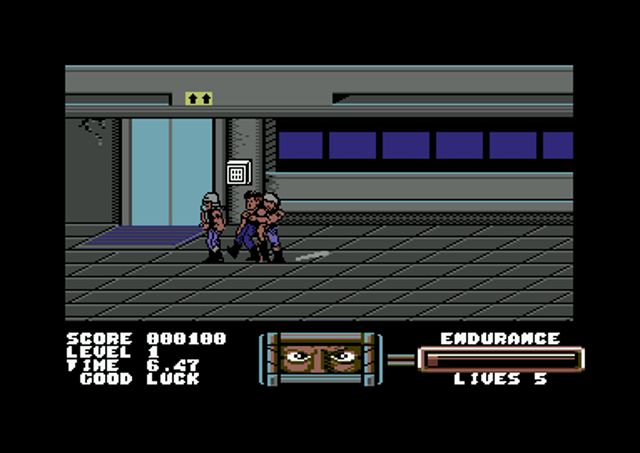
Mr. Big has not only killed your brother and kidnapped your girlfriend, but he’s also sending bikers, pimps, prostitutes, skinheads and even vicious dogs after you now…! You’re not going stand for that shit, so it’s time to fight back! After you beat up an entire biker-gang in a multi-story car park, you hit the town and go after Mr. Big and his army of thugs. At the end of each level you get a phone call from someone who probably tells you where to go next. Target Renegade has a strangely overpowering atmosphere which makes it more memorable than for example the sequel Renegade III – The Final Chapter. Great controls and even greater visuals make this one of the finest brawlers on the machine. Excellent music and sound effects as well. (Not simultaneously, though.) The bullets riddling the Game Over-screen is an extra nice detail.
40. Task III (Databyte Ltd., 1987)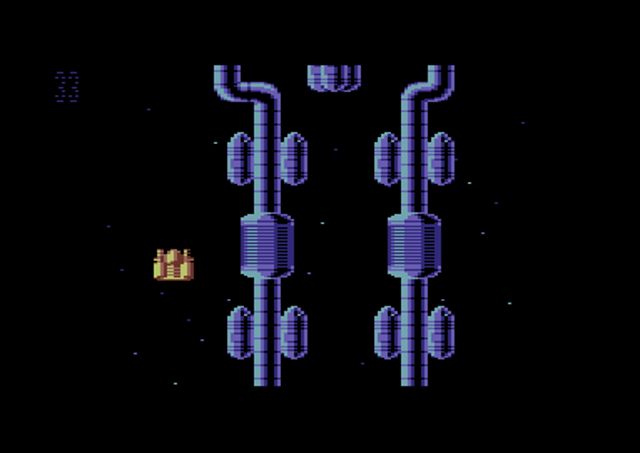
Okay, so there were no Bullet Hell STGs for the C-64, but Task III (It’s actually called that, and it’s not a sequel to the non-existing Task II.) is by no means a breeze to fly through – 16 sadistically difficult levels of vertical alien-blasting and obstacle-avoiding. (The game even has a “Suicide Bonus” if you crash into a wall without having killed a single thing.) And your fast space ship can turn on a dime. That’s right – You can fly through each level both up and down. It’s extremely hard, yes, but the game looks absolutely stunning – It was probably the closest to a contemporary arcade-game you could get with these 8-bits. And Frank Endler’s title- and high score music is just so bloody good.
41. Thing Bounces Back (Gremlin Graphics, 1987)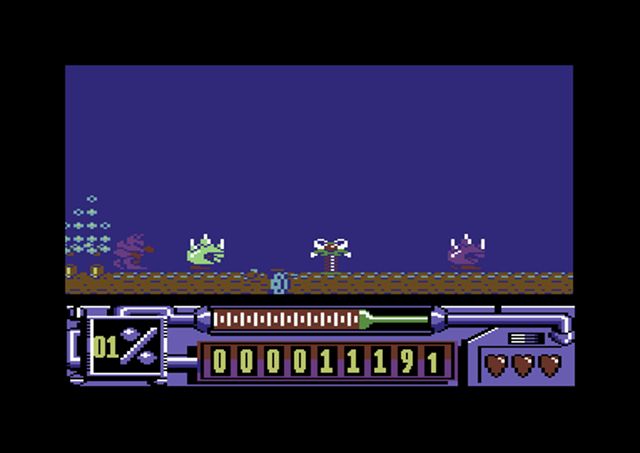
The sequel to Thing On A Spring generally just feels like a better game in every sense – It looks better, it has better level design and better (Frustrating!) platforming action. It’s also a bigger game with eleven levels all tied together with a zero-gravity-like maze that Thing uses to get to the various sections. Rob Hubbard’s jolly tune has also been updated and remixed by none other than Ben Daglish. Thing Bounces Back will probably piss you off to no end at times, but mostly, it’s tricky in the right way – Even if the controls take a while to get used to.
42. Tir Na Nog (Gargoyle Games, 1985)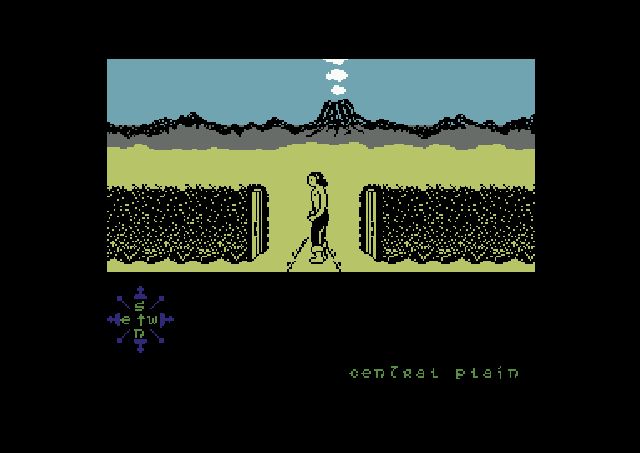
Like straight from the ZX Spectrum. But hidden within this silent game (A few beeps here and there don’t count.) with its somewhat clunky controls (You only move left and right, but have to change the angle of the game area in order to move up or down.) and characteristic monochrome graphics is a huge adventure game that entirely draws its concept from Celtic mythology. You play as Cuchulainn and your mission is to retrieve the magic Seal Of Calum. What made this game revolutionary was its map size and design, and more so its beautiful and fluid animations and background graphics. It’s almost like watching a cartoon.
43. Train, The – Escape To Normandy (Accolade, 1988)
It’s WWII and the Nazis has crammed a train full of stolen art and valuables. They plan to take it from Normandy across the German border, so you have to prevent this by “borrowing” the train and driving it to safety. The game is actually a mix of a couple of mini-games. First of all, there are the shootouts at the train-stations. Then, you have to get the train moving, which basically is a steam-locomotive “simulator” where a number of things can go wrong. While the train is running, you more than often have to shoot down attacking planes using a machine gun mounted on the roof. And from the bridges, you can sink enemy gunboats as well. At the next station (after another shootout), you can check out your next objective. And you have to make sure not to damage the train too much. All in all, a palatable and surprisingly varied game.
44. TRAZ (Cascade Games, 1988)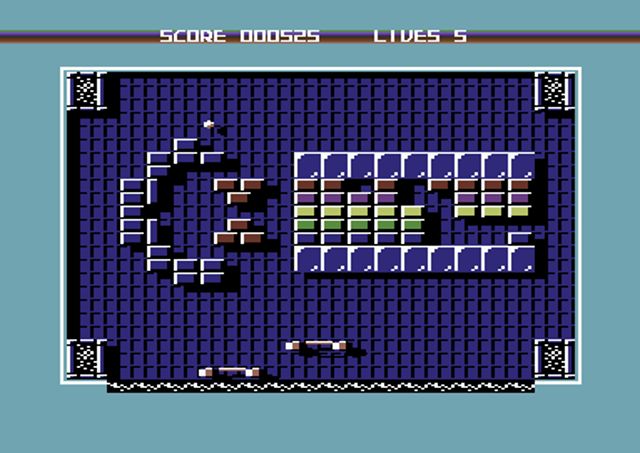
Just when you thought that the ideas for yet another Breakout-game were drying up, along came TRAZ: Transformable Arcade Zone. Cascade Games really put an effort in trying to come up with new ideas and features for their version of Arkanoid. And they succeeded. It’s still classic Breakout, but you control either one or multiple bats (Or you can have a second human player help you.), and after completing each level, you choose which level you want to play next. Like in all other good Breakout games, there are hidden bonuses in the bricks and annoying moving objects that occasionally make you slip. TRAZ also includes a neat construction set. Another game that didn’t get enough love, I think.
45. Tusker (System 3, 1989)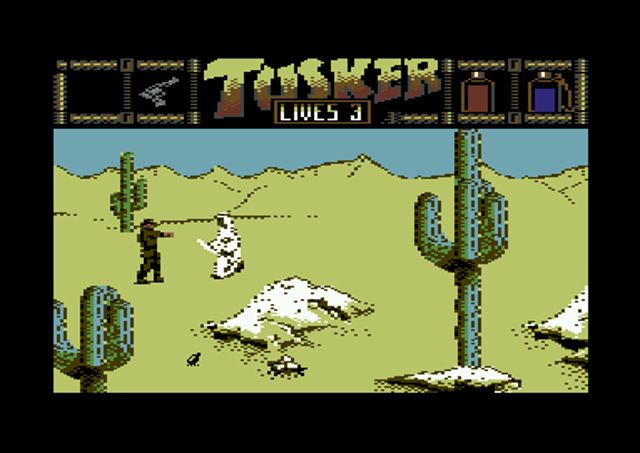
Tusker is one Indiana Jones-looking mofo doing Indiana Jones-stuff out in the boonies (Somewhere in Africa.) as he’s looking for the legendary Elephant’s Graveyard. The legend is apparently tied to Tusker’s destiny in more ways than his name, so of course he sets out to solve the mystery. Be prepared to be attacked by everything from Bedouins and dangerous animals to living mummies and sea monsters on your adventures. System 3 keeps delivering the top games, and comparisons to Last Ninja are practically unavoidable. Tusker doesn’t exactly play like Last Ninja, but there are similarities – The recognizable style, the marvelous graphics, the amount of details and the design. And one or two of Matt Gray’s great tunes could be lifted directly from Last Ninja 2.
46. Untouchables, The (Ocean Software, 1989)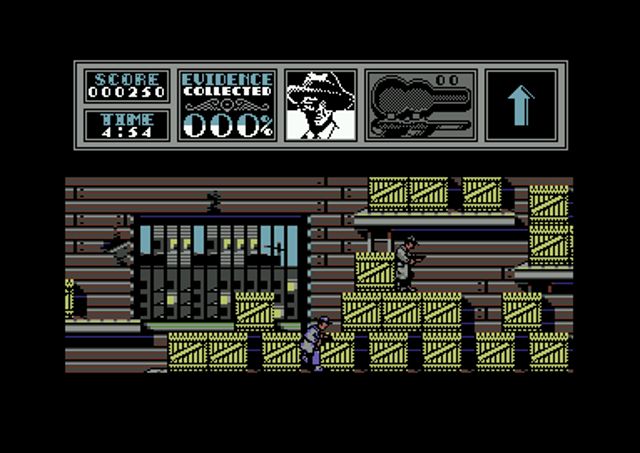
I don’t think there ever was a specific era when movie license games were known for their high quality. But Ocean Software cranked out a handful of lustrous and highly playable ones when they put some real effort into them. I think both Robocop and Batman: The Movie fall under that category. But most of all, so does this one. The Untouchables consists of six different mini-games that all involve firefights somehow. The first segment is a standard platformer while four of the others are shooting galleries. If you have seen the film, you can easily see which one of the more action-oriented parts they were trying to implement in the game. (Most notably the stairway-scene with the baby-carriage.) Untouchables has top-of-the-line “old timey” visuals and suitable ragtime-tunes. Really entertaining overall.
47. Vendetta (System 3, 1990)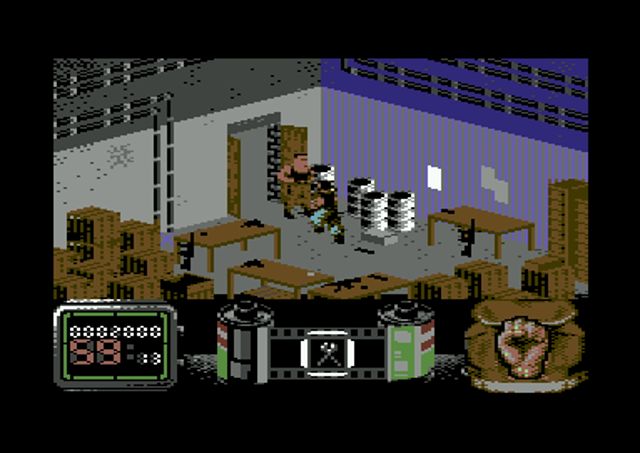
Terrorists have kidnapped a young woman in her home and you set out to rescue her. (There is a real back story, actually. And the kidnapping is shown as a nice “surveillance video tape”-intro before the game.) After raiding a warehouse in the docklands and arming yourself with hand grenades and a couple of guns, it’s time to beat ass. There are four Last Ninja-style levels where you look for clues and decimate the terrorists plus four driving sections which take you to the next area with a Ferrari F40. Since Vendetta is a System 3-game, you can expect a high quality game without being disappointed. The controls take some time to get used to, though. And don’t expect the driving levels to be anything like Ridge Racer, or something. I mentioned it at the beginning, but the C-64 just couldn’t handle those types of games.
48. Wizball (Ocean Software, 1987)
A wizard and his cat fly around in ball-shaped vessels through landscapes drained of color, and the objective is to collect red, blue and green paint while you shoot down waves of enemies. The paint is used to color the levels and you also have to mix colors to get different hues. By holding down the Fire-button you control the cat’s vessel since that one has the ability to collect the falling drops of paint. The Wizball can be equipped with weapons like lasers, smart bombs and shields. Between each level you have a bonus stage / Shoot ’em-Up-sequence before you get to your color-mixing laboratory. Wizball just deserves all the praise it got – Every little thing about it is perfect thanks to Sensible Software and Martin Galway. Absolutely mesmerizing. (And a cool guitar solo as the Game Over-jingle!)
49. World Games (Epyx, 1986)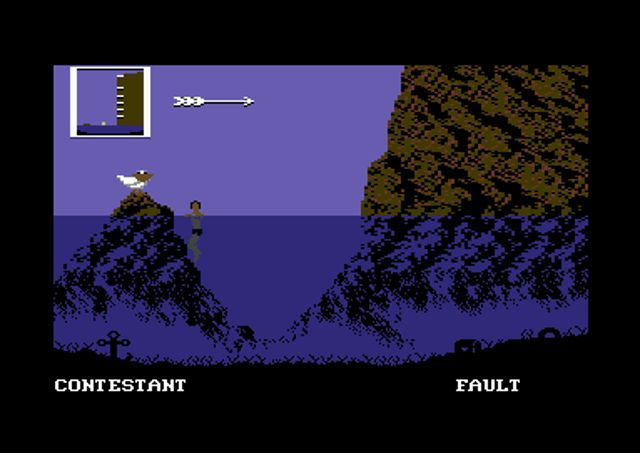
I name dropped this earlier, but it just had to be here. Summer Games and Winter Games were good and everything, but this is where Epyx really outdid themselves and improved on everything that they already were famous for. All the subtle details help to create that special “Epyx”-atmosphere. In World Games you travel to eight different countries around the world to compete in Weight Lifting, Slalom Skiing, Log Rolling, Cliff Diving, Caber Toss, Bull Riding, Barrel Jumping and Sumo Wrestling. Each sport has its own features, techniques and changeable difficulty level, but most of all – It’s just fun to figure them out and compete with either family members or friends.
50. X-Out (Rainbow Arts, 1989)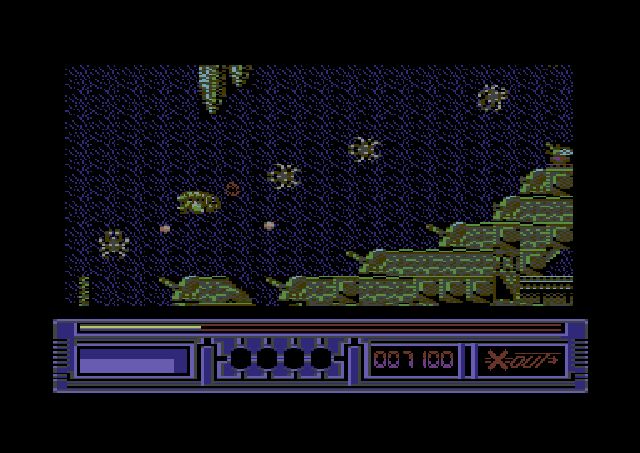
That this game was impressive on the Amiga was one thing. But seeing it on the C-64 with pretty much everything from its 16-bit counterpart… That’s something else. Yes, it’s another side-scrolling R-Type-game, but in this one, you solely fight the aliens underwater and you configure the submarine of your choice with different weapons and protective upgrades. Eight very difficult levels await you, and you spend your hard-earned cash in the shops between levels – Essentially, you have to choose between buying extra subs (lives) or better weapons. Jörg Prenzing and Golden Goblins made a beautiful job with the conversion and F.A.M.E. did wonders with Chris Hülsbeck’s original soundtrack.
And there you have it. 50 games that I think has stood the test of time and give you a good overall picture of what the C-64 was capable of. And while we’re at it – Let’s have some honorable mentions that almost made it to the list:
- Airborne Ranger – An early stealth operations game that was pretty amazing when it came out. It still is.
- Aliens – An abandoned space station. (Except it’s overrun by aliens.) 250 rooms to explore. Six characters (Ripley and company.) that you control one at a time. The game still holds up, and Electric Dreams successfully recreated some of the atmosphere from the hit movie.
- Batman: The Movie – Like I said about The Untouchables, Ocean Software got some of their movie license-games right. This one also had five sections – Two platform-stages, two driving stages and one “Simon Says”-like mini-game. There was just the feeling that there should have been a bit more in a game called Batman: The Movie.
- Combat School – Surprisingly good port of Konami’s arcade, but the developers probably got a bit lazy when they did the second part of the game. It’s really lacking.
- Games, The: Summer Edition / Winter Edition – More Epyx sport titles released back when the summer and winter Olympics still took place in the same year. I think these games were far better than the original Summer Games and Winter Games.
- Green Beret – Pretty good conversion, but it gets it many extra points for its haunting loading music and excellent title tune – Both by Martin Galway. The arcade version (Rush ‘n Attack) didn’t have anything like that…!
- Shockway Rider – Battle street gangs on three parallel sidewalks that move at different speeds. It’s fun – For a while… Still – The game’s fantastic Rob Hubbard-soundtrack and the odd game design is worth mentioning.
- Turbo OutRun – Unlike OutRun on the C-64, this one was very well made… But the hardware just couldn’t keep up. Like at all. Maniacs Of Noise’s music saves the game, though.
- Turrican – Sure, the C-64-version paled graphics- and sound-wise when compared to the Amiga-version. Turrican is a very “Amiga” game and almost made us believe that it really was Game Over for the C-64 . But that doesn’t take away from the fact that the C-64-version plays just as well and looks really good. It’s just a shame that half the levels lack in-game music.
- Ultimate Play The Game – The six C-64 exclusives. The Staff Of Karnath, Entombed, Imhotep, Blackwyche, Outlaws and Dragon Skulle. Adventure / action games. From Ultimate. ‘Nuff said.
I deliberately picked out games that are possible or even easy to find on eBay (That’s why “The Great Giana Sisters” wasn’t on the list when it most certainly should have been.) in case you decide to start collecting physical releases of these games on either cassette or disk. The other option is to dig into the world of Commodore 64 through the power of emulation. My original C-64s broke down years and years ago, and I just don’t have the room for another one, including peripherals, in my living room. (Or even the money for all these classics that I’d like to own.)
Going through 50 games and playing them all for thirty minutes in average (Except Elite – I put way over 100 hours into it back in the days.) was also a pleasant and nostalgic journey for this aging geek, and it only confirmed the fact that I always loved the C-64 more than the Amiga. What these software developers did during the golden years, 1987-89 (19 of the games in this list are from 1987 and 10 are from 1988.), on this five plus year old machine was nothing short of magic. I hope you can discover or relive that magic too if you haven’t. Keep one relatively small but important corner of the past alive.

